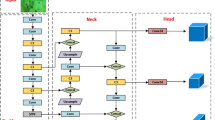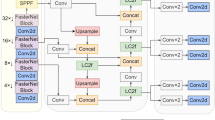Abstract
Aiming at the problem of insufficient storage space and limited computing ability of underwater mobile devices, an underwater garbage detection algorithm based on an improved YOLOv5s algorithm is proposed. The algorithm replaces the feature extraction module of the YOLOv5s network with the lightweight network MobileNetv3; the Convolutional Block Attention Module (CBAM) is embedded in the network to improve the feature extraction ability of the network in two dimensions of space and channel. At the same time, the improved network is pruned to reduce the redundant parameters and further compress the model. The experimental results show that the detection accuracy of the approach can reach 97.5% based on one-ninth of the parameters of YOLOv5s, and the real-time detection speed on the CPU is 2.5 times that of YOLOv5s.









Similar content being viewed by others
References
Akib, A., Tasnim, F., Biswas, D., et al.: Unmanned floating waste collecting robot. In: 2019 IEEE region 10 conference (TENCON), pp. 2645–2650. IEEE (2020)
Bochkovskiy A., Wang C.Y., Liao H.: YOLOv4: optimal speed and accuracy of object detection (2020). arXiv:2004.10934
Fang, P., Zheng, M., Fei, L.A., et al.: S-FPN: a shortcut feature pyramid network for sea cucumber detection in underwater images. Expert Syst. Appl. 182, 1–13 (2021)
Fulton, M., Hong, J., Islam, M.J., et al.: Robotic detection of marine litter using deep visual detection models. In: 2019 international conference on robotics and automation (ICRA), pp. 5752–5758 (2019)
Girshick, R., Donahue, J., Darrell, T., et al.: Rich feature hierarchies for accurate object detection and semantic segmentation. In: 2014 IEEE conference on computer vision and pattern recognition (CVPR), pp. 580–587. IEEE (2014)
Han, K., Wang, Y., Tian Q., et al.: GhostNet: more features from cheap operations (2019). arXiv:1911.11907
Hong J, Fulton M, Sattar J.: A generative approach towards improved robotic detection of marine litter. In: 2020 IEEE international conference on robotics and automation (ICRA), pp. 10525–10531. IEEE (2020)
Howard, A., Sandler, M., Chen, B., et al.: Searching for MobileNetV3. In: 2019 IEEE/cvf international conference on computer vision (ICCV), pp. 1–11. IEEE (2019)
Howard, A.G., Zhu, M., Chen, B., et al.: MobileNet: efficient convolutional neural networks for mobile vision applications (2017). arXiv:1608.08710
Hu, J., Shen, L., Albanie, S., et al.: Squeeze-and-excitation networks. IEEE Trans. Pattern Anal. Mach. Intell. 42(8), 2011–2023 (2020)
Huang, S., Huang, M., Zhang, Y., et al.: Under water object detection based on concolution neural network. In: 16th international conference on web information systems and applications conference, pp. 47–58 (2019)
Ju, M.R., Luo, H.B., Liu, G.Q., et al.: Infrared dim small target detection network based on spatial attention mechanism. Opt. Precis. Eng. 29(4), 1–11 (2021)
Lei, J., Gao, X., Song, J., et al.: A review of deep network model compression. J. Softw. 29(2), 251–266 (2018)
Li, H., Kadav, A., Durdanovic, I., et al.: Pruning Filters for Efficient ConvNets (2016). arXiv:1608.08710
Lian, J., Yin, Y., Li, L., et al.: Small object detection in traffic scenes based on attention feature fusion. Sensors 21(9), 3031 (2021)
Lin, T.Y., Goyal, P., Girshick, R., et al.: Focal loss for dense object detection. In: IEEE transactions on pattern analysis and machine intelligence, pp. 2980–2988. IEEE (2018)
Liu, W., Anguelov, D., Erhan, D., et al.: SSD: single shot multibox detector. In: 14th European conference on computer vision (ECCV), pp. 21–37 (2016)
Madricardo, F., Ghezzo, M., Nesto, N., et al.: How to deal with seafloor marine litter: an overview of the state-of-the-art and future perspectives. Front. Mar. Sci. 7, 1–16 (2020)
Mesfer, A.D., Haya, M.A., Fahd, N., et al.: Intelligent deep learning based automated fish detection model for UWSN. Comput. Mater. Continua 70(3), 5871–5887 (2021)
Mukherjee S., Valenzise G., Cheng I..: Potential of deep features for opinion-unaware, distortion-unaware, no-reference image quality assessment. In: Lecture notes in computer science, pp. 87–95. Springer (2020)
Redmon, J., Divvala, S., Girshick, R., et al.: You only look once: unified, real-time object detection. In: 2016 IEEE conference on computer vision and pattern recognition (CVPR), pp. 779–788. IEEE (2016)
Ruangpayoongsak, N., Sumroengrit, J., Leanglum, M .: A floating waste scooper robot on water surface. In:2017 17th international conference on control, automation and systems (ICCAS), pp. 1543–1548. IEEE (2017)
Sandler, M., Howard, A., Zhu, M., et al.: mobilenetv2: inverted residuals and linear bottlenecks. In: 2018 IEEE/CVF conference on computer vision and pattern recognition, pp. 4510–4520. IEEE (2018)
Senouci, B., Charfi, I., Heyrman, B., et al.: Fast prototyping of a SoC-based smart-camera: a real-time fall detection case study. J. Real-Time Image Proc. 12(4), 649–662 (2016)
Shi, P.F., Xu, X.W., Ni, J.J., et al.: Underwater biological detection algorithm based on improved faster-RCNN. Water 13(17), 2420 (2021)
Tajar, A.T., Ramazani, A., Mansoorizadeh, M.: A lightweight Tiny-YOLOv3 vehicle detection approach. J. Real-Time Image Proc. 18(6), 2389–2401 (2021)
Woo, S., Park, J., Lee, J.Y., et al.: CBAM: convolutional block attention module. In: 15th European conference on computer science (ECCV), pp. 3–19 (2018)
Yang, K.J., Yang, J.X., Chen, B.S., et al.: Methods of defect detection in transmission line based on depthwise separable convolution and SVD. Smart Power 48(10), 64–69 (2020)
Yang, Y.M., Liao, Y.R., Lin, C.B., et al.: A review of target detection algorithms for lightweight convolutional neural networks. Ship Electron. Eng. 41(4), 31–36 (2021)
Zhang Q., Jiang Z., Lu Q., et al.: Split to be slim: an overlooked redundancy in vanilla convolution (2020). arXiv:2006.12085
Zheng, Z., Wang, P., Liu, W., et al.: Distance-IoU Loss: faster and better learning for bounding box regression (2020). https://doi.org/10.1609/aaai.v34i07.6999
Author information
Authors and Affiliations
Corresponding author
Additional information
Publisher's Note
Springer Nature remains neutral with regard to jurisdictional claims in published maps and institutional affiliations.
Rights and permissions
About this article
Cite this article
Wu, C., Sun, Y., Wang, T. et al. Underwater trash detection algorithm based on improved YOLOv5s. J Real-Time Image Proc 19, 911–920 (2022). https://doi.org/10.1007/s11554-022-01232-0
Received:
Accepted:
Published:
Issue Date:
DOI: https://doi.org/10.1007/s11554-022-01232-0




